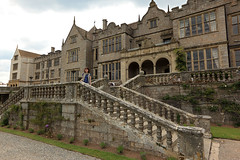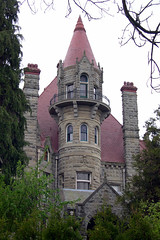

| Archive Blog Cast Forum RSS Books! Poll Results About Search Fan Art Podcast More Stuff Random |
|
Classic comic reruns every day
|
1 {photo of the Tower of London, blurred to look ethereal and spooky}
1 Caption: Haunted
|
First (1) | Previous (3260) | Next (3262) || Latest Rerun (2888) |
Latest New (5380) First 5 | Previous 5 | Next 5 | Latest 5 Annotations theme: First | Previous | Next | Latest || First 5 | Previous 5 | Next 5 | Latest 5 This strip's permanent URL: http://www.irregularwebcomic.net/3261.html
Annotations off: turn on
Annotations on: turn off
|
 The Tower of London. Haunted by the ghosts of Anne Boleyn, Catherine Howard, Sir Walter Raleigh, King Henry VI, among others. |
One thing Ackroyd does state in the introduction is that England seems to have the richest supply of ghost stories. I suspect he means "in the English speaking world", at which point the reason becomes fairly obvious. England has the longest history of any English speaking culture, giving it so much more time to accumulate stories. Indeed, some of the ghosts in the book date from medieval times, and many from around the Renaissance. My own home of Australia, which certainly does have plenty of ghost stories, simply doesn't have the same length or population density of European habitation to accumulate as many in sheer number.
An interesting thing about the ghosts described in the book is how few of them conform to common stereotypes about ghostly apparitions. Not one clanks chains and makes mournful moaning sounds, nor manifests as a figure draped in a sheet. Instead we hear stories of ghosts who are often at first not recognised as such, appearing simply as a solid-looking, flesh-and-blood person. It's only when the observer realises no such person can be there, or the apparition vanishes suddenly, that the ghostly nature becomes apparent.
Another striking thing about the stories in Ackroyd's book is how few of them involve fear of the ghosts. We have been conditioned by horror stories and films to think of ghosts as terrifying, or at least creepy. But many of the observers in the book regard the apparitions with mere curiosity, puzzlement, or even acceptance. Some of the witnesses claim to have lived with the ghosts for years and to regard them as familiar and even comforting. There are some fear-inspiring tales in the mix though, with a handful of the traditional stories about sceptical people staying the night in an allegedly haunted house and ending up fleeing in terror.
 Convict church, Port Arthur, Tasmania. Haunted by the ghosts of convicts who made a murder-suicide pact to escape their earthly torment in this brutal penal colony. |
And there are the noisy, violent ghosts known as poltergeists. These create mysterious noises—thumps and crashes that keep residents awake at night—and move or throw objects around, but are never seen. One could suppose that odd noises in the night are simply the odd creaks and groans that any old building makes, amplified in human awareness by the still of the nether hours. Objects being spontaneously tossed around is harder to reconcile. Another feature of poltergeist reports is that although the objects sometimes hit people with what seems like great force, they never do any significant injury. This requires changes to the laws of physics and biology if objects really did fly through the air and hit victims, or neither if they were just imagined.
Ghosts are commonly supposed to be the restless souls of the departed, somehow prevented from journeying to whatever place it is that souls normally go to after death. They are in this sense frustrated, and out of place, which is part of what gives them their otherworldly creepiness in our minds. It is a fear of death and the unknown that projects onto the idea of ghosts, if not always on to specific sightings. A problem with this explanation of ghosts is that people also claim to have witnessed ghosts of animals (which many mainstream religious doctrines deny have souls), and also of vehicles or other inanimate objects. While this could be interpreted as a difficulty with the "lost soul" hypothesis, an intriguing approach is to consider that maybe inanimate objects also have some form of soul - which leads to a sort of animistic worldview.
 Winchester Mystery House, San Jose, California. Haunted by the souls killed by Winchester rifles. |
There are other possibilities of course. The human mind is a surprisingly fragile and suggestible thing, much more so than many people realise. A misinterpreted sound here, a strange thing seen out of the corner of an eye, a disturbance caused by an animal, acting on a mind primed by folklore and already apprehensive because of the darkness of the night and unfamiliar surroundings - all of these things can combine to convince a person they experienced something eerie and out of this world.
Nevertheless, the idea of ghosts is an appealing one. For those who believe in immortal souls, ghosts offer the comforting thought that the vast majority of people go to their intended afterlives, while presenting tragic tales of the few that are foiled. Stories of ghosts who carry on to perform a duty or to bring the downfall of someone who wronged them offer the fulfilment of justice extending beyond the grave. Who doesn't want to see a bad guy get their comeuppance at the hands of a spectral victim? And tales of general terror and mayhem have always been popular, so ghosts get a look in there as well, as simple monsters.
 Bovey Castle, Dartmoor, Devon. Home of the spectral Hound of the Baskervilles (in the 1930 film). |
And so we come to forms of fiction. Ghosts have featured in stories for thousands of years, in all of the forms mentioned above. Charles Dickens used them as agents of conscience in A Christmas Carol. Horror writers have used them as perpetrators of sheer terror. Tolkien used them as restless souls, eager to make amends by fulfilling an oath made in life. Casper is friendly and frequently misunderstood, suitable for children's tales. Every so often ghosts become fashionable subjects for films, in the 1980s, and again in the past few years.
And roleplaying games are forms of fiction, created by a group effort. Ghosts have long featured in game settings. Dungeons & Dragons alone has had, over its publication history, dozens of different types of ghosts. There are so many that they were given a name as a sub-type of undead monsters: spectral undead. Basically, any form of ghost legend or story from myth or history has been co-opted into what is the "English language" of roleplaying games.[1] Not just that, any synonym for the word "ghost", be it from English or almost any other language in existence, has been turned into a specific form of ghostly monster in the game. And so we have ghosts, spectres, poltergeists, phantoms, wraiths, shades, death knights, allips, revenants, shadows, haunts, apparitions...
 Craigdarroch Castle, Victoria, British Columbia. Haunted by former owner Joan Dunsmuir, a crying child, and a self-playing piano. |
You may have begun reading this today wondering why someone as apparently rational and scientific as me cares about ghosts. As with many other things on the fringes of myth and the supernatural, I find them fascinating for two reasons. Firstly the study of legends is an interesting and worthy pastime in itself. They may or may not tell you anything about the reality of spirits and souls - that's really secondary to the fact that they are often just really cool stories.
And secondly, legends inspire creativity. Recycling legends to use in a game may not sound particularly creative, but creating a compelling game experience for players is a difficult task, and you need to leverage everything you can get your hands on. It's all well and good to make up new monsters from whole cloth, and sometimes that works brilliantly[2], but the disadvantage is that people encountering them for the first time won't get that immediate gut impact for how terrifying these things should be. You need to put in hard work to establish the fear factor. But insert a well-known creature from legend, and everyone knows to run in fear. That, my friends, is worth its weight in gold.
Not that ghosts have weight.. but never mind that for now. Until next time... sleep well and don't let those bumps in the night keep you awake.
The problem with defending the purity of the English language is that English is about as pure as a cribhouse whore. We don't just borrow words; on occasion, English has pursued other languages down alleyways to beat them unconscious and rifle their pockets for new vocabulary.If you're a myth or a legend, and you're walking down a dark alleyway, you really don't want to see Dungeons & Dragons following you...
[2] Weeping angels, I'm looking at you!
Yes, literally, damnit!
|
LEGO® is a registered trademark of the LEGO Group of companies,
which does not sponsor, authorise, or endorse this site. This material is presented in accordance with the LEGO® Fair Play Guidelines. |